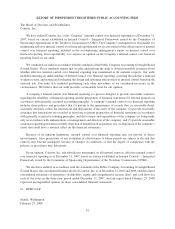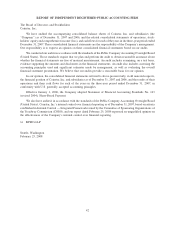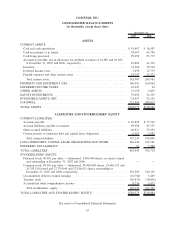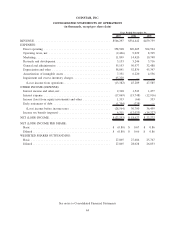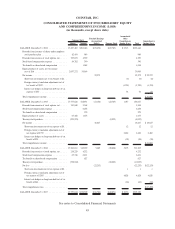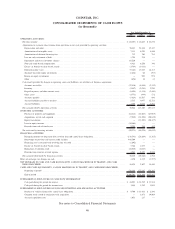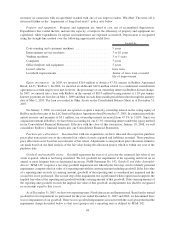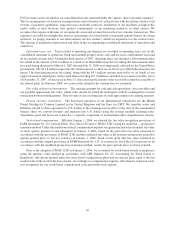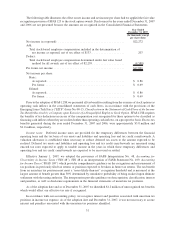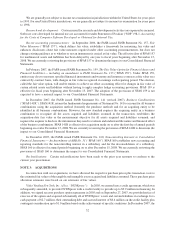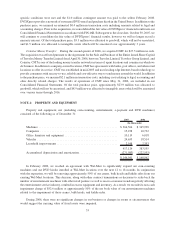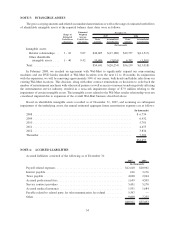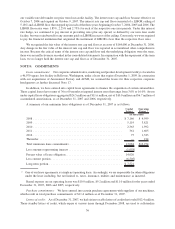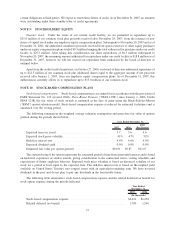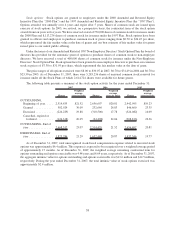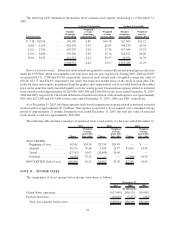Redbox 2007 Annual Report Download - page 51
Download and view the complete annual report
Please find page 51 of the 2007 Redbox annual report below. You can navigate through the pages in the report by either clicking on the pages listed below, or by using the keyword search tool below to find specific information within the annual report.Our intangible assets are comprised primarily of retailer relationships acquired in connection with our
acquisitions through the end of 2007. We used expectations of future cash flows to estimate the fair value of the
acquired retailer relationships. We amortize our intangible assets on a straight-line basis over their expected useful
lives which range between 1 and 40 years.
Patent costs: Costs to successfully defend a challenge to our patents are capitalized. Costs which relate to an
unsuccessful outcome are charged to expense.
Impairment of long-lived assets: Long-lived assets, such as property and equipment and purchased intan-
gibles subject to amortization, are reviewed for impairment at least annually or whenever events or changes in
circumstances indicate that the carrying amount of an asset may not be recoverable. Factors that would indicate
potential impairment include, but are not limited to, significant decreases in the market value of the long-lived
asset(s), a significant change in the long-lived asset’s physical condition and operating or cash flow losses
associated with the use of the long-lived asset. Recoverability of assets to be held and used is measured by a
comparison of the carrying amount of an asset group to the estimated undiscounted future cash flows expected to be
generated by the asset group. If the carrying amount of an asset group exceeds its estimated future cash flows, an
impairment charge is recognized in the amount by which the carrying amount of the asset group exceeds the fair
value of the asset group. While we continue to review and analyze many factors that can impact our business in the
future, our analyses are subjective and are based on conditions existing at, and trends leading up to, the time the
estimates and assumptions are made. Actual results could differ materially from these estimates and assumptions.
Prior to December 31, 2007, Wal-Mart management expressed its intent to reset and optimize its store
entrances. In February 2008, we reached an agreement with Wal-Mart to significantly expand our coin-counting
machines and our DVD kiosk locations over the next 12 to 18 months. In conjunction with the expansion, we will be
removing approximately 50% of our cranes, bulk heads, and kiddie rides from our existing Wal-Mart locations. This
decision, along with other contract terminations or decisions to scale-back the number of entertainment machines
with other retail partners as well as macro-economic trends negatively affecting the entertainment service industry,
resulted in excess equipment and inventory. As a result, we recorded a non-cash impairment charge of $65.2 million
as of December 31, 2007 related to an asset group that includes this equipment and certain intangible assets. Of this
amount, $52.6 million relates to the impairment of these cranes, bulk heads and kiddie rides, $7.9 million relates to
the impairment of certain intangible assets and $4.7 million relates to the write-off of excess inventory. We
estimated the fair values of these assets using discounted cash flows, or liquidation value for certain assets, which
we considered an appropriate method in the circumstance.
Settlement of liabilities: In accordance with FASB Statement No. 140, Accounting for Transfers and
Servicing of Financial Assets and Extinguishments of Liabilities (“SFAS 140”), we consider liabilities to be
extinguished when the debtor pays or is legally released from the obligation. During the first quarter of 2007, the
company reversed liabilities totaling $870,000 in accordance with SFAS 140.
Revenue recognition: We recognize revenue as follows:
• Coin-counting revenue is recognized at the time the consumers’ coins are counted by our coin-counting
machines;
• Entertainment services revenue is recognized at the time cash is deposited in our machines. Cash deposited
in the machines that has not yet been collected is referred to as cash in machine and is estimated at period end
and reported on the balance sheet as cash in machine or in transit. This estimate is based on the average daily
revenue per machine, multiplied by the number of days since the coin in the machine has been collected. The
estimated value of our entertainment services cash in machine was approximately $8.4 million and
$7.1 million as of December 31, 2007 and 2006, respectively;
• E-payment services revenue is recognized at the point of sale based on our commissions earned, net of
retailer fees. Money transfer revenue is recognized at the time the customer completes the transaction.
Fees paid to retailers: Fees paid to retailers relate to the amount we pay our retailers for the benefit of placing
our machines in their stores and their agreement to provide certain services on our behalf to our customers. The fee
is generally calculated as a percentage of each coin-counting transaction or as a percentage of our entertainment and
49




